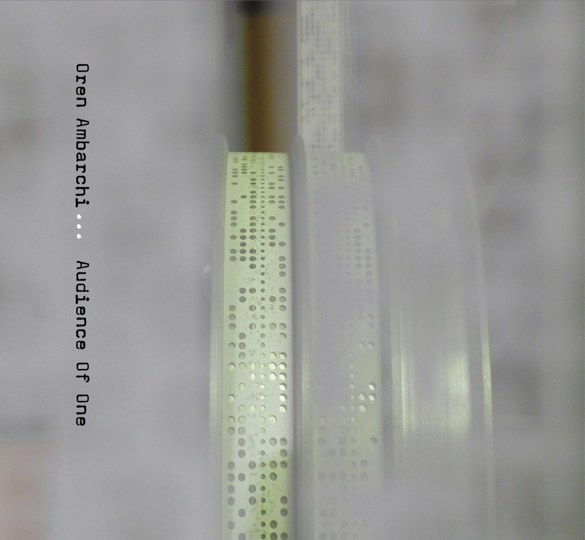The word “collaboration” must come natural to Australian artist Oren Ambarchi, whose wide-ranging back catalogue from the past decade includes multiples appearances on Sunn O))) albums, to releases with Jim O’Rourke. But all this working with others hasn’t left Ambarchi longing for some alone time; his most recent release, Audience of One, involves a plentiful amount of other artists chipping in to add to the end result.
Perhaps the most notable appearance – if not the most obvious – is that of Warm Ghost member Paul Duncan, whose vocal talents are brought in on opening track “Salt.” On the track, Duncan sings in an almost mournful manner over some dreamy Brain Eno-esque synths, as a string section fades in a light crescendo. For an artist renowned for his left-field approaches to playing guitar, the track is an almost beautiful side-step from what might be expected, sounding altogether absent of guitar (the album notes, however, do credit Ambarchi’s guitar playing on the track). This slow, peaceful tone is carried forward onto “Passage” as some sparse piano chords are peppered amongst gasps of wordless female vocals and between the wavering tones created by Ambarchi playing some wine glasses to wonderful effect.
However, despite the presence of other artists, Ambarchi is still running the show, and the album is quite undeniably his mind wanting to wander and explore ideas, sounds, and textures. And this is most evident in the 33-minute behemoth of a track “Knots” where he… well, I don’t know what he’s doing, if I’m to be completely honest. The track swells carefully for the first half, bellowing occasionally with foghorn-like moans of noise before something that sounds identifiable as a guitar enters after the fifteen minute mark. From there he fidgets, attacks, and manipulates the strings of his instrument, creating a cacophony of noise as tangled and complicated as the title “Knots” might suggest. It’s a great example of drone and free-jazz coming together, but listening to the whole thing is a hefty undertaking that never feels quite as rewarding as it should.
It could be, though, that I’m engaging with it in the wrong way. Part of me waits and listens for a crescendo of some sorts, but unless I listen intently for the full 33-minutes and latch onto the hugely elongated swelling of the music, there’s nothing more than a half hour wall of noise in my ears. Another thing that riles me up about the track is the ending: once the fuzzy, raped sounds of electric guitar falls away, the tracks slows down before a series of noises take focus, which sound like Ambarchi breaking the strings on his guitar, or hitting the connecting cable to his amplifier with his instrument. And theses noises are cool, and devastatingly interesting to hear, jolting you back into consciousness. But they go on for a solid five minutes, wearing out their interest, and quickly becoming difficult to listen to.
I understand that Ambarchi probably isn’t out to make music that easy in the ear, but the five minutes guitar snapping thing is part of the track’s ten-minute comedown – which is needed for a track as huge as “Knots.” But the fact we get the climax and the comedown within the one track makes the following track — the earlier mentioned lulling number, “Passage” — essentially redundant. “Passage” is lovely and peaceful, but by the end of “Knots” I’m ready for another climax or crescendo to emerge instead of lingering in the peaceful lack of distorted guitar. Things do pick up again, though, when fourth track “Fractured Mirror” emerges from the ambience with its pleasant, almost summery finger-picked guitar melodies. And “Fractured Mirror” turns out to be the most pleasant thing here, casually breezing by in no time, despite the actual eight minute track length. The chord patterns are kept interesting, never settling on what sounds like simple repetition, and constantly ambling forwards (which has to be credited, I suppose, to Ace Frehley, whose track Ambarchi is covering). Come the end of the track, I’m ready to be intensely thrilled again with something deep and loud.
But nothing arrives. The album is only four tracks, and “Knots” is the centrepiece; come the end of the album, there’s an unfortunate sense of disappointment. For what it is, and at its best moments, “Knots” is inspired and interesting, but, as said, it asks a lot of the listener, and the payoff isn’t always there. I could see myself enjoying — and revisiting- the material of Audience of One more if there was a greater selection on offer, or even just something that felt easier to find a way into. Alas, the more accessible tracks on the album seem to have to submit to the carnivorous size of “Knots,” and, as a result, are easy to be deemed forgotten. The focus of the album is obvious, and whether or not the majority of listeners end up enjoying it, it’s what Audience of One will be remembered for.

